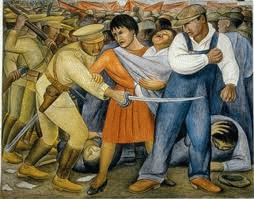When I visited New York's Museum of Modern Art's retrospective of celebrated Mexican painter Diego Rivera I was reminded of Yogi Berra's quip: "It's deja vu all over again." Rivera's murals span Mexico's history back to the Spanish conquistadors and powerfully depict class inequality and social injustice. They dramatize the protest and rebellion of an oppressed majority of indigenous natives, underclass workers, and the poor against a small dictatorial ruling class. Hmm, where have I heard that theme recently?
Rivera's murals were created eighty years ago, but they are just as relevant today. His paintings speak directly to the Occupy Wall Street (OWS) movement. Their chilling contemporary resonance calls attention to a long history, covering many cultures over the centuries, of the battle between the 99 percent and the 1 percent. Just change the uniforms and weapons of the armed soldiers in Rivera's mural The Uprising, and it could be a current workers protest scene in Los Angeles, Arizona, or Texas-- with the same Latino faces.
For OWS the message is clear. It's time to put an end to the harsh legacy of stifling inequality.
MOMA, just two years old in 1931, mounted Diego Rivera's retrospective to record-breaking crowds -- far exceeding the attendance at the first solo exhibit of world renowned French impressionist Henri Matisse months earlier. That speaks to the popularity and magnetism of Diego Rivera's art.
Rivera couldn't bring his murals to New York for the show. His frescoes were painted on walls in various locations in Mexico City. By definition, frescoes are fixed in place and, therefore, can't be packed up for travel. Instead, MOMA ingeniously ensconced Rivera in a studio on the sixth floor of the Heckscher Building, 730 Fifth Ave at 57th Street, the location of the fledgling MOMA, which consisted of just six galleries on the 12th floor. As noted by curator Leah Dickerman in a December 8th interview with WYNC Public Radio host Leonard Lopate, Rivera worked feverishly around the clock for six weeks while he entertained and conversed with prominent visitors in his open studio. It's surprising that Rivera was the darling of New York's wealthy and elite, since he was an avowed outspoken communist.
Miraculously, Rivera produced five "portable" murals using a process that he invented for the exhibit. Four were remakes of murals that he had completed in Mexico. One, The Uprising, was entirely new. His creations were real murals, painted on layers of concrete and mortar covered with plaster that were embedded in metal diagonal and cross bars and steel mesh, all held together by a steel outer frame. The process is described and illustrated in two of the displays at the exhibit. But portable did not be mean light. The largest mural weighed a thousand pounds. Moving them from Rivera's sixth floor studio to the 12th floor galleries was a grueling challenge.
Rivera painted three more murals after the show opened, bringing the total to eight. The new works focused on an aspect of New York City life that captivated Rivera: the stark contrast between rich and poor -- between the glitz of the soaring Manhattan skyline and the city's grimy underbelly of industrious workers who made the glitz possible. Even though Rivera's murals were displayed at the height of the Great Depression in 1931, New York was ironically in the midst of a frenzied construction boom fueled by the deep pockets of the 1 percent and the availability of cheap labor due to the 25 percent unemployment rate.
If you saw Rivera's mural, Frozen Assets, on a poster at Zuccotti Park, you wouldn't have suspected that it was produced eight decades ago. More likely, you might have been tempted to see if the paint had dried, since the mural speaks so specifically to the moment and graphically grasps the heart and soul of OWS. It embodies the outcries of all the protest posters.
The mural consists of three successive sections. At the top is a montage of skyline buildings, including Rockefeller Center, which was under construction at the time. Directly below are sleeping bodies lined up like sardines in a homeless shelter modeled after the Municipal Pier shelter for unemployed men on 25th Street. The bottom panel is a bank vault, where the rich count their money and examine their assets in a guarded fortress.
One painting says it all!
OWS has pretty much been driven out of Zuccotti Park. But it's alive and thriving in the art of Diego Rivera at MOMA.
The exhibit continues through May 14, 2012. Don't miss it!






